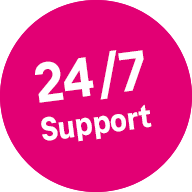From the initial contact to error-free operation, the Open Telekom Cloud experts are happy to help you in person. And best of all, telephone and email support is already included in our offer.


From the initial contact to error-free operation, the Open Telekom Cloud experts are happy to help you in person. And best of all, telephone and email support is already included in our offer.
We believe that exceptional service is a key part of a great offering. That’s why our support team is ready to assist you with any questions about the Open Telekom Cloud.
Cloudia, our smart AI chatbot, is also here to help – providing quick, accurate answers anytime, conveniently via chat.

The community offers you these and other possibilities:

Here you can find a quick and comprehensive guide to the most important tools that give you an independent insight into the world of the Open Telekom Cloud and the opportunities it offers.


The most important applications explained in detail.
Tutorials


Current status of the Open Telekom Cloud platform.
Status Dashboard

Updates und new features of Open Telekom Cloud.
To Release Notes

Our prices and services in detail.
Service description incl. price list
Pricing Models

Book various training packages as required.

Everything about switching under the Data Act and the application form

Answers to possible questions and problems.
FAQ: General Questions
FAQ: Private Link Access Service (PLAS)


* Voucher can be redeemed until December 31, 2025. Please contact us when using the voucher for booking. The discount is only valid for customers with a billing address in Germany and expires two months after conclusion of the contract. The credit is deducted according to the valid list prices as per the service description. Payment of the credit in cash is excluded.


* Voucher can be redeemed until December 31, 2025. Please contact us when using the voucher for booking. The discount is only valid for customers with a billing address in Germany and expires two months after conclusion of the contract. The credit is deducted according to the valid list prices as per the service description. Payment of the credit in cash is excluded.
The Open Telekom Cloud Community
This is where users, developers and product owners meet to help each other, share knowledge and discuss.
Free expert hotline
Our certified cloud experts provide you with personal service free of charge.
0800 3304477 (from Germany)
+800 33044770 (from abroad)
24 hours a day, seven days a week
Write an E-Mail
Our customer service is available free of charge via E-Mail
AIssistant Cloudia
Our AI-powered search helps with your cloud needs.